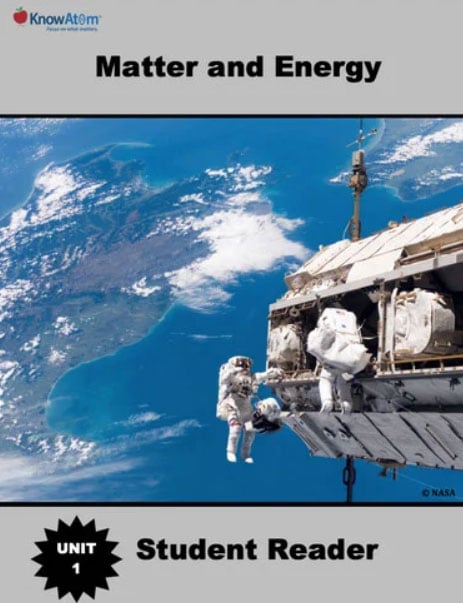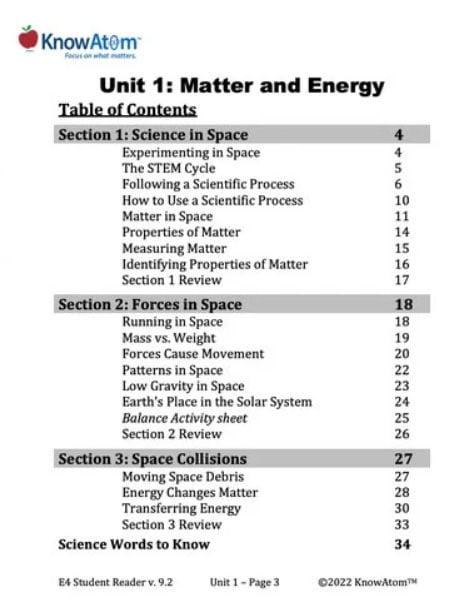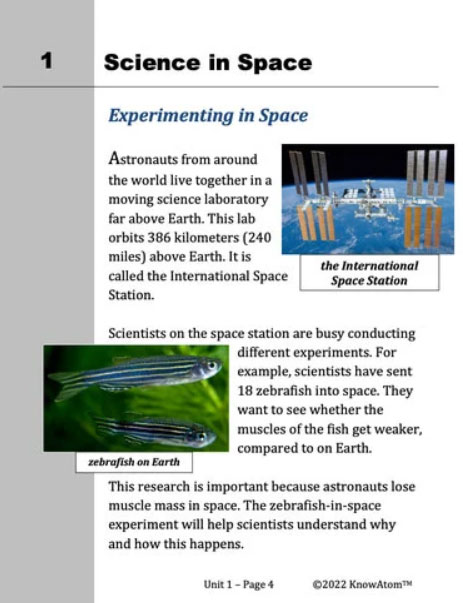Science background gives teachers more in-depth information on the topic explored in this unit. Below is an excerpt from this section for the lesson on properties of matter.
In every experiment, whether on Earth or on the space station, matter and energy are constantly interacting. In fact, all of science begins with a basic understanding of matter—everything that has mass and takes up space. Matter makes up all of the substances in the universe. All matter contains energy, and matter only changes when enough energy is present. For example, zebrafish are made of matter, but they can only survive and grow when they eat enough food, which has energy.
All matter is made of atoms, which are the smallest pieces of matter that have the properties of an element. An element is a substance made up entirely of one kind of atom. Atoms are so tiny that we cannot see them. Just one grain of sand is made up of many millions of atoms. Because of this, scientists use scale to better understand the size of an atom, the parts that make it up, and how it relates to everyday substances. Scale is the size, extent, or importance (magnitude) of something relative to something else. For example, think about all of the atoms that make up a grapefruit. If each atom were the size of a blueberry, the grapefruit would have to be the size of Earth. There are so many atoms in just one grapefruit that they are impossible to count. Imagine having to fill up the entire planet with blueberries. That’s about how many atoms are in one grapefruit.
Atoms themselves are made up of smaller particles, called protons, neutrons, and electrons. These smaller particles are called subatomic particles. These smaller particles are much smaller than the atom itself. For example, the protons and neutrons group together in the atom’s core, called the nucleus. If you were to open up the blueberry (representing the atom), the nucleus would be too small to see.
If you were to make the blueberry the size of a football field, you would just be able to see the nucleus. It would be the size of a small marble. The nucleus is very dense because it holds all of the atom’s protons and neutrons. The electrons are in constant motion around the nucleus. However, most of the atom is filled with empty space. There are vast regions of space between each of the electrons and between the electrons and the nucleus.
As of 2023, scientists have discovered 118 kinds of elements. These 118 elements are the only substances needed to form all of the matter in the universe. For this reason, atoms are called the building blocks of matter, and they can join together in different ways. Two or more atoms joined together are called molecules.
The number and types of atoms that make up matter determine the properties of an object or substance. Properties are observable or measurable characteristics of matter. For example, gold atoms conduct electricity, and helium atoms are a gas at room temperature.
All matter has both physical and chemical properties. Physical properties are characteristics of an object or substance as it exists. Physical properties include color, odor, mass, volume, shape, boiling point, and melting point. Scientists and engineers need to know the properties of various materials when they think about how those materials will be used.
For example, the outer shell of the International Space Station’s modules is made of mostly aluminum. Aluminum is light-weight, yet strong, which means it is easier to lift into orbit from Earth. It is also flexible and smooth, so it can be molded into various forms.
Properties also change as atoms form bonds and combine. For example, aluminum oxide is a molecule made from two aluminum atoms and three oxygen atoms. It commonly exists as a gas Water (H2O) is a molecule made from two hydrogen atoms and one oxygen atom. The properties of water (H2O) are different from the properties of the atoms it is made from. For example, at normal room temperature, both oxygen and hydrogen are gasses. When atoms of hydrogen and oxygen join as a molecule of water, they change into a liquid.
Mass is a physical property of matter. Mass is the amount of matter an object or substance has packed inside. Scientists measure mass in grams (g). Mass increases as the number and size of atoms increase in an object. An aluminum foil roll is less massive than a gold brick because aluminum atoms have less atomic mass than gold atoms. Pan balances are instruments used to compare a known mass to an unknown mass. Digital or electronic scales can also be used to measure mass.










